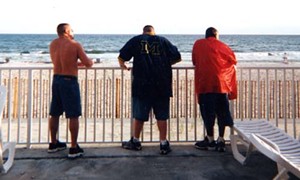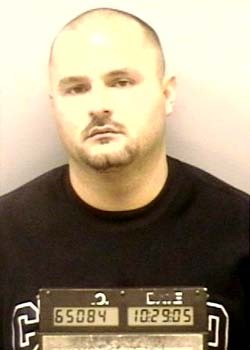On Oct. 28, 2005, Danny J. Sidener Jr. went to Family Video on MacArthur Boulevard to accept a delivery from a Chicago business associate. This associate arrived 20 minutes earlier than expected, and Sidener didn’t handle the merchandise as carefully as usual when he tucked it into the carpet-covered wheel-well of his rented Pontiac Grand Am. No matter; he planned to dispose of the stuff quickly. He drove about a block and a half down Leland Avenue, to his cousin Michael Mohan’s house. Mohan wasn’t home yet, so Sidener parked in the driveway and leaned against his car to wait. When Mohan arrived, they went inside, Sidener carrying a blue bag. Three minutes later he was back in his car, headed north on MacArthur. Somewhere along the way he got a call from a friend who had heard Mohan’s address broadcast over a police scanner. Realizing that he was probably being followed, Sidener took ever-smaller side streets, still heading north toward his cousin’s home near Camp Lincoln. At the corner of Elliott Street and a tiny lane called Kings Highway, Sidener’s car collided with an Illinois State Police vehicle, and Sidener was taken into custody.
In that instant, he realized that his long and highly profitable career as a cocaine dealer was over. But instead of feeling fear, anger, or panic, Sidener felt a huge sense of relief, even gratitude. “When I get out of here,” he says, speaking from a federal prison, “I’m gonna look back and I know I’m gonna tell myself it’s the best thing that could’ve happened to me.”
In the months following the arrest, Sidener’s name appeared incessantly in media reports. He wasn’t just any dope dealer; he was the top man in an organization that included recognizable names from local legal and political circles among its clientele. By the time authorities ended the “Springfield cocaine ring” probe, Sidener and eight other men had pleaded guilty to drug trafficking and nine more had been held under scrutiny by a special prosecutor. Yet in all the coverage, few details surfaced about the now-29-year-old Springfield native who built an illicit-drug operation over the course of almost a decade. Illinois Times applied to interview Sidener at the Forrest City Federal Correctional Complex, in Forrest City, Ark., but the warden declined the request because of “safety and security considerations.” Instead, prison officials facilitated two question-and-answer sessions between Sidener and a reporter, first by phone, then by fax. Sidener also designated an older cousin to talk about his past. These conversations provide a glimpse into the sometimes scary, sometimes boring, always creative, and occasionally comical existence of a full-time professional drug dealer. They also show how Danny Sidener managed to peddle marijuana and cocaine for eight years before finally getting caught.
First of all, forget all the B-movie clichés. There were no flashy cars or gaudy jewelry, just the low-key accoutrements of a well-heeled but uncomfortable lifestyle. There was no force or discipline within the organization, just hanging out and partying together. Sidener’s operation wasn’t a gang; it was more like a family business. It started, Sidener says, with a pound of weed.
In 1997 he graduated from Southeast High School and enrolled at Northern Illinois University in DeKalb. Having been a standout running back for the Spartans, he hoped to play football for NIU. Instead he got homesick, dropped out of school, and returned to Springfield, bunking at friends’ houses during the week in the hope that his mother wouldn’t find out (she soon did). To make money, he started “investing in marijuana” — first a pound, then 2, then 3, then 10. Within six months, he was up to 50 pounds; next thing he knew, he was buying 100 pounds at a pop. “I did have some piddly-ass job, though I’m sure I hated it,” Sidener says. “I don’t have any passion for working under anyone. I never will.”
Around 1998 or ’99, his supply of cannabis suddenly disappeared and Sidener had to diversify. Customers had been asking him about cocaine, so he found a Chicago supplier and bought a quarter-kilogram (9 ounces). His second purchase was a kilo. “From there on it was nonstop,” Sidener says. “Whatever the people wanted: 100 pounds, 500 pounds, 5 keys, 10 keys. Whatever.” As he reels these numbers off, there’s no pride in his voice, perhaps because a corrections-department counselor is monitoring Sidener’s end of the interview or maybe because he has, as he insists, started a new chapter in life. “This is a huge turnaround for me,” he says. In 2000, the market in Springfield came under some heat, and Sidener moved to Chicago. “Several search warrants were being served during this period . . . [with] warrants that came from phony trash-rips — the same ones you hear about today,” Sidener says, referring to the work of some Springfield police detectives [see “Above the law,” Sept. 28, 2006]. “My [suppliers] wanted me out of that area. I think maybe they wanted to keep an eye on me.”
But after six or eight months he moved back home, partly for the same reason he dropped out of college — to be near his family and friends — and partly because he felt safer here. “It was easier for me to be around Springfield, where I can maneuver,” he says. Sidener had relatives and lifelong pals here whom he could trust to handle the drugs he was bringing in from Chicago. Two cousins — Mohan and Earl Sidener — and a high-school football buddy named Jerrad Pruitt received the bulk of the dope and allocated it to other distributors. Though Sidener and several other members of the group carried handguns, he chuckles at the notion that their activities could be called organized crime. “They were family members. Whether they were organized or not, I dunno. Not really — we weren’t a gang or nothing. To other people it might seem like that, but not to me,” he says. “I mean, I didn’t have no control over them or nothing. Everybody knew what to do.”
Business thrived. Asked how much money he made between the time he began dealing in 1997 and his arrest in 2005, Sidener can only estimate: “Definitely in the millions.”
He developed a pattern of distributing the product to Mohan, Pruitt, and Earl Sidener the day he took delivery from Chicago — usually once or twice a month — then taking his time collecting payment. The secret of his success was how he managed that money. “A lotta people, as soon as they make money, they go spend it immediately. I just kept compounding it,” Sidener says. “I always had a goal. The first one was like $50,000. Then next one was like $500,000. The last one was like a million. I never reached it. I got cut off.”
Finding ways to deal with all that illegal cash required ingenuity. He used the small change to pay his supplier and hoarded the $100 bills, because they were easier to hide. There were the usual places — wall safes, floor safes, deposit boxes, behind drywall, under false flooring – and the not-so-usual, such as a secret compartment inside a car parked inside a storage unit. “This is never-ending,” Sidener says. Of course, the easiest stuff to squirrel away was the invisible loot — debt that could be held and then harvested when needed. “Money is sometimes safer when other people owe you money,” Sidener says. He erased $10,000 drug debts “more times than I can count on both hands.”
He invested in real estate, buying and rehabbing small houses in Springfield and Taylorville. He bought three vacant lots along the train tracks on South Sixth Street. He dabbled in contracting, building a couple of homes near Lake Springfield. He also bought an abundance of goodwill, giving away an estimated $1 million to friends and relatives whenever they needed a little help. “Houses, cars, cash, bills — everybody has to eat,” Sidener says. He doesn’t offer any details, but other people do. The cousin he has designated to answer questions speaks on the condition that his name not be used, but he says Sidener provided both the moral and the monetary support he needed to go straight after his own state-prison sentence for selling marijuana. “He put me through barber college so I could get my license, and he bought me a car so I wouldn’t have to do anything stupid,” says the cousin. “He wanted to keep me on the right track. He didn’t want to lose me again.”
The cousin claims that he has been law-abiding since: “This is my hustle now, cutting hair.”
Sidener’s largesse extended beyond family, according to his cousin. Once, when they were out at a bar, Sidener overheard the cousin’s friend lamenting that he couldn’t go visit his young daughter in Colorado because he didn’t have a reliable vehicle. Sidener gave this man he barely knew the car he was driving that night — a late-model Ford Taurus. He even lent a former high-school classmate — a platonic female friend — money for breast-augmentation surgery, then declined repayment. “I loved to be able to help people,” Sidener says. “I’ll do the same when I get home — help those less fortunate than others.”
He apparently didn’t spend lavishly on himself. He wore a gold chain and a fancy watch that his cousin says was probably just a nice fake, and he had a fondness for expensive sports jerseys. He sometimes whiled away his abundant free time by gambling on football and online casino games. But at the time of his arrest he lived in a small, nondescript beige house with a big picture window that blended perfectly with everything else in a working-class Taylorville neighborhood. “He had a decent TV and nice furniture but nothing way pricey. Didn’t get too crazy,” says his cousin. “He had small little features, like two heads in the shower.”
Sidener also didn’t succumb to the product he sold. “Cocaine was rarely appealing unless I was intoxicated,” he says. “I drank most weekends and sometimes during the week. Not every day. I wasn’t a junkie.”
In fact, going cold turkey after his arrest presented no problem. “I don’t believe I’ll drink or use again,” he says.
He came close to getting caught a time or two. In 2000 or 2001, Sidener says, he was approached at a carwash on Sangamon Avenue by Paul Carpenter, then an SPD detective. Sidener didn’t have a valid driver’s license, and he was certain Carpenter knew that. They chatted for five or 10 minutes, but Carpenter made no move to arrest Sidener for driving illegally. “He let me go. Paul is not petty like some cops I know,” Sidener says. “But little did Paul know I had 20 pounds of weed in my vehicle.”
Another time, when he was driving home to Taylorville, drunk and speeding, he noticed flashing red and blue lights behind him and realized he was going to be stopped. He suddenly remembered that the handgun on the back floorboard might be loaded (he says he had been at the shooting range), and, not wanting to risk losing his FOID card, he decided to dismantle the weapon. As he explained a few months later, in a handwritten letter to U.S. District Judge Jeanne Scott, his “intoxication and clumziness [sic]” hampered his efforts, and he not only crashed into some construction barricades but also, in the confusion, cocked the weapon. He ended up throwing the gun out the window. The cops who stopped him found it, but later dropped the charge.

“Toward the end, it seemed like he was more paranoid,” the cousin says. Sidener says the same thing. He had the usual paranoia that comes with cocaine use, increased exponentially by the illegal and dangerous job of wholesaling loads of the stuff it. Yet he couldn’t kick the habit.
“The money’s more addictive than the drug itself. It made my life a mess,” he says. “I spent a lot of time looking in my rearview, spotting suspicious vehicles that look like police, looking for airplanes that keep flying in circles, nosy neighbors, odd vans parked outside . . . everything. This causes is a lot of stress, pressure, paranoia. This is the part that sucks.”
Still, despite these obsessive fears, Sidener didn’t worry when he heard that one of his distributor’s customers had become a snitch and was cooperating with law-enforcement authorities. “We hear this stuff all the time. You know, I’ve heard that about myself,” he says. “And [the distributor] knew all them politicians and stuff; he figured that if that was true they would’ve told him.”
According to court documents, the ring began to fall apart in April 2005, when law enforcement officers found 14 ounces of powder cocaine during the execution of a search warrant on a residence. The resident quickly turned informant and is identified in court documents only as “CS #1” (confidential source 1). In May, CS #1 allowed the Illinois State Police to record his conversation while he bought 223 grams of cocaine from his usual supplier, Adam Martin. In July, CS #1 purchased 200 grams of cocaine at Martin’s Lindbergh Boulevard duplex from Martin’s source, Mohan, who told CS #1 that he had a half-kilo available. Mohan also said he could entrust CS #1 with full kilos to sell. Drug agents recorded the entire conversation on audio and video. In September, law-enforcement authorities received permission from Judge Scott to intercept calls on two cell phones used by Mohan, and they began to hear Mohan talking to Danny Sidener, using what seemed like coded language referring to drug distribution. In one, Mohan sounds like he’s planning a cookout, but he’s really telling Sidener that he has a customer who needs a larger-than-average supply of cocaine for the weekend: “If you could bring some steak, that would be sweet, but if you can’t, I mean, call the meat man and tell him we’re gonna have a party,” Mohan says. On Sept. 30, a surveillance team watched Sidener drive up to Mohan’s house in a blue Yukon and then leave, followed by Mohan’s blue Ford Explorer. Agents followed Mohan to the west-side home of “Distributor #2,” probably Gerald Vondebur, who lived on Fairway Lane (court documents indicate that he received 500 grams of cocaine that day). Two weeks later, agents intercepted a series of phone calls in which Mohan tried to get directions from Sidener on where to find a kilo of cocaine. After showing up at Sidener’s home just before 9 a.m., Mohan drove a few blocks to a vacant house that Sidener owned and called him again, asking where the “rock” was located. “I must’ve told him to come out in the morning and forgot all about it,” Sidener says. “I was . . . still up from the night before getting high.” The “rock” was a fake stone in the front yard, used to hide a key. Mohan finally found the key, let himself into the house, and took the kilogram of cocaine. Soon after, Scott signed an order allowing investigators to monitor Sidener’s cell phone, and within a week agents heard Sidener, Mohan, and Earl Sidener coordinating plans to receive a delivery on Oct. 28. Both Sideners and Mohan were arrested that evening. Martin was arrested the next day. Over the next few weeks, Sidener’s uncle Peter Sidener, plus Vondebur, William W. Thomas, and Dondi McIntosh, were also arrested, as was Pruitt, despite the fact that he had been out of the business for more than a year. Peter Sidener, Mohan, Pruitt, and Thomas were each indicted on conspiracy to distribute at least 500 grams of cocaine. Vondebur, McIntosh, Danny and Earl Sidener were each indicted on conspiracy to distribute 5 or more kilograms of cocaine; Danny Sidener also faced a weapons charge for the 9mm handgun and 16 rounds of ammunition found in his car. For three hours, Sidener recalls, he sat alone in a holding cell at the local Drug Enforcement Agency office with nothing to do but try to gauge the magnitude of the mess he was in: “I tried to think, ‘What do they got? What’s going on here? Do they really know? Did they find that half-kilogram in the trunk of the car? What should I do?’ I tried to weigh it out.”
He would keep quiet, say nothing — at least that’s what he had always promised himself. But he knew that agents had found the 1.5 kilograms he had delivered to Mohan, and the packaging had his fingerprints on it. “I usually don’t touch them. I never touch them, but I was in a hurry,” Sidener says. Plus, as the hours crept by, he began to realize that the agents must be debriefing someone else. One thing he didn’t even consider was calling a lawyer. He preferred to handle this situation on his own. When it was his turn to be questioned, Sidener angled to get the agents to divulge what they already knew. As it turned out, they knew a lot. Sidener waived his Miranda rights and saved the cops the trouble of searching alleys and Dumpsters by telling them where to find the half-kilo hidden in his car. He also answered their questions about his Chicago source, but that person has never been arrested. Asked why, Sidener doesn’t have much to say. “Well, I guess they couldn’t put enough together. Maybe they didn’t have enough time to catch him, or I didn’t give ’em enough information or something. I had a separate [prepaid] phone to call him from, so they never knew about him,” Sidener says. “But I don’t really wanna talk about that.”
His decision to cooperate was the lesser of two selfish choices, Sidener says. “It was either be selfish and tell on all these [co-conspirators] or be selfish and leave my family out to dry,” he says. “I mean, 30 to 40 years is what they were gonna give me if I hadn’t cooperated.”
He wasn’t the only one. The other participants in the family business also talked to the agents. “Yeah, yeah, yeah — I think every single one of them,” Sidener says. “The feds put a lotta pressure on you.”
But is he angry? Perhaps at CS #1, who was never publicly identified, never charged with any crime? “No, no,” Sidener insists. “If that didn’t happen, something else would’ve happened eventually. I’m not mad at anyone. I put myself in this situation — ain’t nobody’s fault but me. If I didn’t make these choices, I wouldn’t be here.”
He expressed the same sentiment on Feb. 26, 2007, at his sentencing hearing in U.S. District Court. He apologized to the judge, then to his family. His older cousin says it was an emotional scene. “Made me cry,” the barber says. “I didn’t wanna break down, but I sure did.”
The one thing Sidener feels no remorse about is the poisonous product he sold. He compares the situation to owning a bar: If one bar closes, the patrons simply buy alcohol elsewhere.
“Consumption is eminent,” he says. “The hand that feeds is irrelevant.”
Sidener now spends his days exercising, studying the stock market, taking classes in financial investment, reading the Bible, and attending church. He’s hooked on day trading and believes that when he’s free he will make enough money legally to recoup all the cash and property he forfeited and then some. “That $500,000 the feds took will look like peanuts. They can have it,” he says. Sentenced to almost 12 years in federal prison, Sidener will spend at least another six or seven years behind bars. Whether his new attitude will last that long remains to be seen. For now, he has no nostalgia for his old lifestyle. “My life was headed for disaster: Huge decline. Self-destruction. Paranoid as hell. Fear of jail, fear of getting robbed or killed, worried about my family and all those people close to me [who] might get caught in the middle somehow. Everybody knew I had money,” he says. “Hard telling what people are plotting — kidnapping, ransom, robbery, whatever. I could have died of a drug overdose. Who knows? I was forced out of this life in the matter of seconds.
“I’m in the best shape of my life now,” he says. “I’m closer to God than ever; I know what I’m gonna do now; I can live in peace, not to mention longer. You can’t sell dope forever.”
Contact Dusty Rhodes at [email protected].























